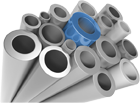Keeping it “Straight”. A “Rough” Hole to Bore
Recent News - May 16, 2016Article on Concentricity – Part One
by Geoff Ginader
President American Hollow Boring
How straight will the hole be when drilling rough bored holes? Straightness of a hole is a typical question in any deep hole drilling project. The industry standard guarantee is less than .001” runout per inch given good material and equipment. Other common answers are “pretty straight,” or “it depends.” This article will seek to inform the reader about what properties may be acceptable for rough bored holes and at which point users may wish to consider finish bored parts for greater precision and quality assurance.
Examples:
- A 2” hole in 6” bar x 20” long may have .020” runout near the exit. (.001”x20”).
- A 3” hole in 8” bar 100” long may have .100” runout near the exit.
In practice runout is usually well under this .001” per inch guideline.
Rough bored holes are generally produced in a single operation with little or no prep. Rough holes may be blind (not through), bored all through from one end, bored from either end, or step bored. Using .001” per inch as a guide, runout can be minimized by boring from either end. In the 100” long example, boring from each end produces no more than .050” runout, but note that mismatch could be as much as .100” in the middle of the piece.
Rough holes can be specified in cost effective ways. Parts can be supplied peeled or rough turned with ends sawn or faced square. Parts can be provided with sufficient OD stock to correct the worst expected runout, and if provided, this stock can be used to turn the OD concentric to the ID. Cold straightening may be required if bars are supplied crooked, so specify if pressing is allowed. Finally, critical areas can be identified on drawings or specs to avoid added cost of holding an entire bore to a close positional tolerance.
Rough bored holes may not come with a uniform surface finish. Although carbide indexable tooling offers high process reliability, rough bored holes may still exhibit marks from chatter, rings, steps and other surface imperfections.
Before shipment, rough bored holes are checked for conformance to the order. Generally, start and finish size, length, OD, wall variation, and results of traceability and visual examination are recorded. Other checks may be specified as appropriate such as use of a drift for clearance fit checks.
In many cases, a rough bored hole is not acceptable for finished parts. Specify finish bored holes if your requirements are for as close as .001” per foot runout. Also, anticipate to have some if not all of the OD stock machined for bores finish bored and finish machined. Remember, it is more demanding of expertise and equipment to get a tight tolerance and finish throughout a deep hole than it is to obtain similar results in a short hole. If straightness is not critical, but finish is critical, you may avoid finish boring and simply rough bore and hone for size and finish. Use finish requirements on drawings or specs to call out required finishes that may be obtained directly from the finish bore, by honing, or machine polishing. In general, to maximize cost effectiveness, specify the roughest operations and widest tolerances. To maximize control of geometry for critical parts, specify tolerances sufficiently for all critical features.
Be sure to contact the experts at American Hollow Boring Co. to review your specific project.
For further reading, American Hollow Boring recommends you refer to Dimensioning and Tolerancing: ASME Y14.5M1994 (Engineering Drawing and Related Documentation Practices)” by the American Society of Mechanical Engineers (ASME), 1995, ISBN10: 0791822230. Coming soon, Part Two of this series of articles on the topic of Finish Bored Hole Straightness.

